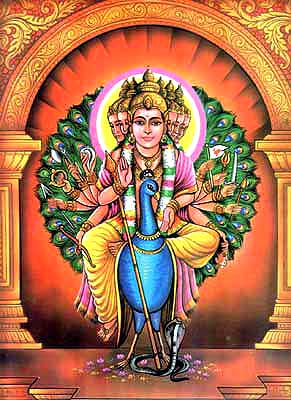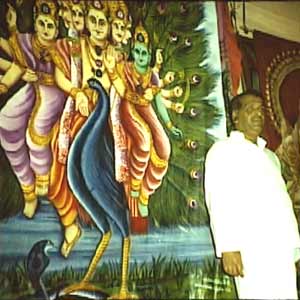
|
||||||
|
| ||||||
Kataragama shrine and ChristianityReproduced from The Island (Colombo) of September 18, 2001.Dr. Felix Fernando,
I reply herewith to the letter of Basil Fernandez (The Island 27 Feb. 2001) on the above subject. I note that Mr. Fernandez agrees that the ritualistic Catholic mass may have had a common origin with the eucharistic type of celebration performed in so-called pagan shrines like the one at Kataragama. Not "may have", Mr. Fernandez, but "did have" will be close to the truth as the evidence is incontestable. In the entire 1900 years or so history of the Catholic Church, it has been extremely reluctant to acknowledge this plain simple and self-evident fact. The striking similarity between the respective rituals has always been a source of embarrassment and discomfort, a thorn in the flesh one might say, to the Roman Church. The only explanation it has ever offered (and this was way back in the second century A.D. when the question was first debated) was the preposterous theory of "diabolical mimicry" put forward by eminent Church Fathers like Justin Martyr and Tertullian in reply to the taunts of equally learned pagan philosophers like Celsus who bluntly accused the Christians of plagiarism i.e. the wholesale criminal and shameless misappropriation of the pagan rites and rituals without so much as a "by your leave please". Wrote Tertullian, "The devil, whose business is to pervert the truth, mimics the exact circumstances of the Divine Sacraments. He baptises his believers and promises forgiveness of sins from the Sacred Fount, and thereby initiates them into the religion of Mithras. Thus he celebrates the oblation of bread and brings in the symbol of the resurrection. Let us, therefore, acknowledge the craftiness of the devil who copies certain things of those that be Divine". If you can bring yourself to believe that, Mr. Fernandez, you can surely believe anything! Matthew 26. 26-28 quoted by Mr. Fernandez (to which might usefully be added Marg 14: 22-23, Luke 22: 15-21, John 6: 22-65 and 1 Corinth 11: 23-26) are most certainly the seminal texts quoted by most Churches as proofs of the institution of the Eucharist by Jesus himself. But it has to be said in all fairness that throughout Church History as a whole, there has always been a great deal of disagreement, leading at times even to physical violence, as to the significance and even the authenticity in part of whole of some of these texts and their bearing on the way the Last Supper is celebrated in different Church communities. The Bible texts clearly depict a very simple and unsophisticated ceremony somewhat like the observances seen today in many Protestant Churches or for that matter at the Kataragama shrine. These simple ceremonies are indeed suggestive of the "fellowship meal" which Jesus and his disciples had when they met for the Lord’s Supper. This may be the reason why some Churches prefer the names Holy Communion or Lord’s Supper which emphasise the fellowship rather than the sacrificial aspects of the rite. The Catholic Mass, on the other hand, is an extremely elaborate affair. A full account of the proceedings is given in the 430 page book "Ceremony of the Roman Rite Described" by Adrian Fortescue, officially approved (Nihil Obstat etc). In this encyclopaedic volume, there are no Bible texts at all, but instead a detailed account of the Rite which seems more paganistic than paganism itself. Everything is there; colourful vestments, gyrations, genuflections, tinkling of bells at appropriate moments, incense, chants, etc. What further proof is needed of the unacknowledged debt to paganism, unless one prefers for sectarian reasons to have his or her blinkers on? At this point another intriguing thought obtrudes itself. While the Catholic Mass is indubitably pagan in form and origin, and grandiose and sacrificial in nature and intent, the Kataragama celebration is simplicity itself, and far more reminiscent of the fellowship meal (Last Supper) of Jesus and his disciples. Could there be something significant in this resemblance? Regarding the "veil being rent" at the shrine, I used this expression in a purely figurative sense to denote the sudden and somewhat dramatic entry of the kapurala (Bethme) into the well of the shrine. From what I understand, the Basnayake Nilame (knows as Maha Bethme in pre-colonial times) does not usually participate in this proceeding except on special occasions. As Mr. Fernandez rightly surmises it was indeed the kapurala and no other who moved the veil aside horizontally. No need whatever to invoke the supernatural, not even diabolical mimicry? I regret any misunderstanding which may have arisen in the mind of Mr. Fernandez on this account. As regards the blessing/approval not being given by the priests for Catholics to visit the Kataragama shrine, I think it is quite understandable. Naturally, they will not like to see the cat let out of the bag. However, it is nice to see that the winds of change have now started blowing in this church which after all is the Mother of all Christian Churches. But there is a lot of unnecessary baggage which will have to be abandoned before the church can come into its own as perhaps the greatest force, institutionally at least at the present, for good in this our trouble society. The public acknowledgement by the present Pope His Holiness Pope Paul John II that there have been many past errors of the church which need to be acknowledged and rectified is indeed worthy of the highest commendation. Kataragama is a place whose origins are shrouded in the mists of antiquity. A good account as any of the known facts appeared in the article "Kataragama: Its origin, era of decline and revival" by Godwin Witane (The Island, Saturday Magazine, March 3). Today, in its sylvan simplicity, it has become a meeting place for adherents of at least four major world religions — Hinduism, Buddhism, Christianity and Islam. These people worship in their own way either in the ancient shrine itself of separately in their own places of worship in the close vicinity, without evincing even a trace of rivalry or animosity. I very much doubt whether this happens anywhere else in the world. Therefore, it should be treated as a national treasure free from political meddling or calumny arising from racial or religious bigotry. This, I think, is what The Island Editor meant when he wrote that editorial (Jan. 8, 2001) captioned "Hands off Kataragama!". [NOTE] The author is expressing his own views and not those of Ruhunu Maha Kataragama Devale. Article courtesy of The Island (Colombo) of September 18, 2001.
|

